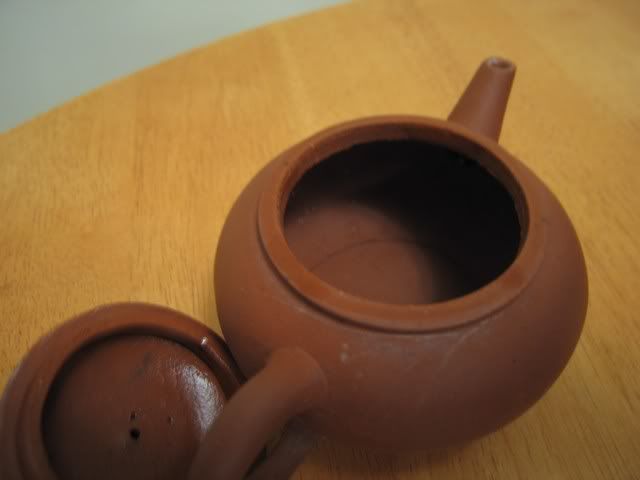Before:




A pretty dirty pot, if I may say so myself. I got this recently, and it hasn’t been cleaned. Time to clean it.
It took a dip in a diluted bleach bath for an hour or two. Then I dunked it in water to try to “de-bleach” the thing. I figured I’d first soak it with some water and see how it does, and then try to do some tea with it. It’s interesting to note that the water turns yellow after a while of soaking — I was using cold water at this point. There’s truth to the “old pots will brew tea on its own” theory.

The pot is now very clean



Now I’m going to let it soak some more, then probably sink it in some tea to wash away the bleach…. then it’s time to try making some tea in this thing.
Exciting, isn’t it? I should’ve taken more chemistry.

 RSS - Posts
RSS - Posts
8 responses so far ↓
xiaobao2008 // April 28, 2008 at 6:14 am |
Tea Seed Power – Exciting Cleaning Power for Yixings
http://houdeblog.com/?p=126
MarshalN // April 28, 2008 at 8:53 am |
I’m not at all convinced that the tea seed oil did much more than regular old water did. If you boil a pot in water long enough a good amount of the stains will come off with some scrubbing.
davelcorp // April 28, 2008 at 11:53 am |
I wonder how hydrogen peroxide would do at cleaning old stains? Have you heard of anyone trying to use that?
shichangpu // April 28, 2008 at 6:47 pm |
one of my pots (a while back) had a stubborn stain/odor to it. the thing that worked the best: denture cleaning tabs. just put the whole thing in a bowl of water, drop in the effervescent tab, and it’s clean overnight. maybe not the most palatable stuff in the world, but makes me feel safer than bleach.
djn7304 // April 28, 2008 at 7:53 pm |
Quick Google search…
According to the NSF, bleach can be safely used to purify water in an emergency. (8 drops per gallon). It’s very alkaline, with a pH of most concentrations between about 11-13.
http://www.nsf.org/consumer/natural_disasters/disaster_water_safety.asp
Bleach is commonly used for cleaning large water storage tanks with several rinses prior to refilling.
Hydrogen Peroxide is also a common disinfectant and good cleaner thanks to it’s strong oxidative properties. And safer than bleach because it quickly disassociates into oxygen and water when used. 🙂
http://en.wikipedia.org/wiki/Hydrogen_peroxide
I think most denture cleaners are acidic. Polident’s website says theirs has a pH of 6.8. Being a proprietary product, I have no idea what’s actually in it, but here’s one patent…and I’m no chemist.
http://www.freepatentsonline.com/5015408.html
djn7304 // April 28, 2008 at 8:06 pm |
Of course, if you’re just looking for a safe abrasive for scrubbing yon pot, my choice would probably be baking sode.
mulcahyfeldman // April 28, 2008 at 11:38 pm |
After taking your boiling advice, my pot smells like fels naphtha; you are probably too young to know what that smells like, it smells like soap. The next step? I think however, it might be an inferior pot, having obtained it from Teavana.
Wesli // April 29, 2008 at 2:56 am |
In the labs, we use thiosodium sulfate, which deactivates bleach like nobody’s business. Stern emasures are taken to keep are research animals away from bleach. Thosodium sulfate, on the other hand, requires naught but a rinse.